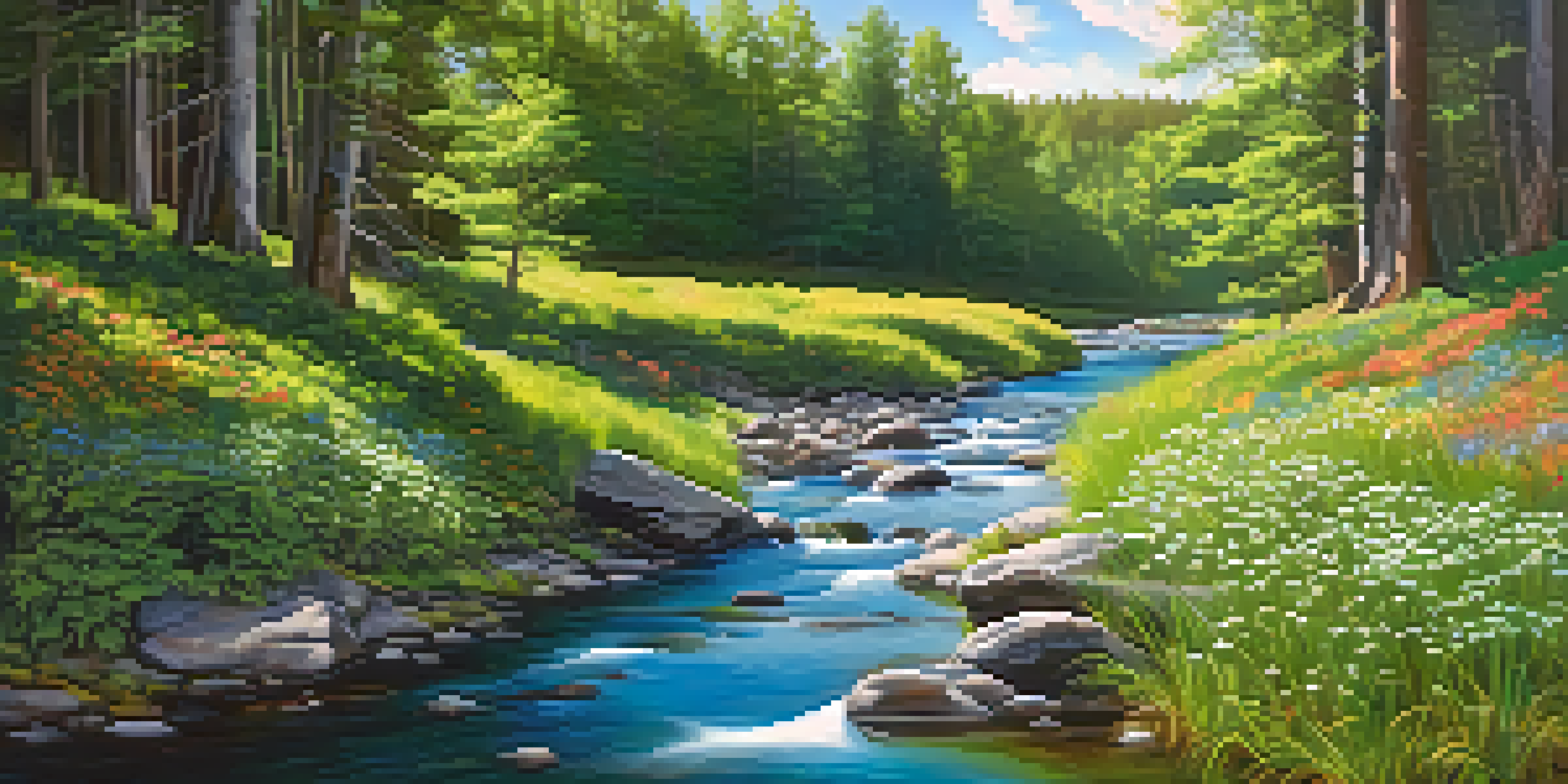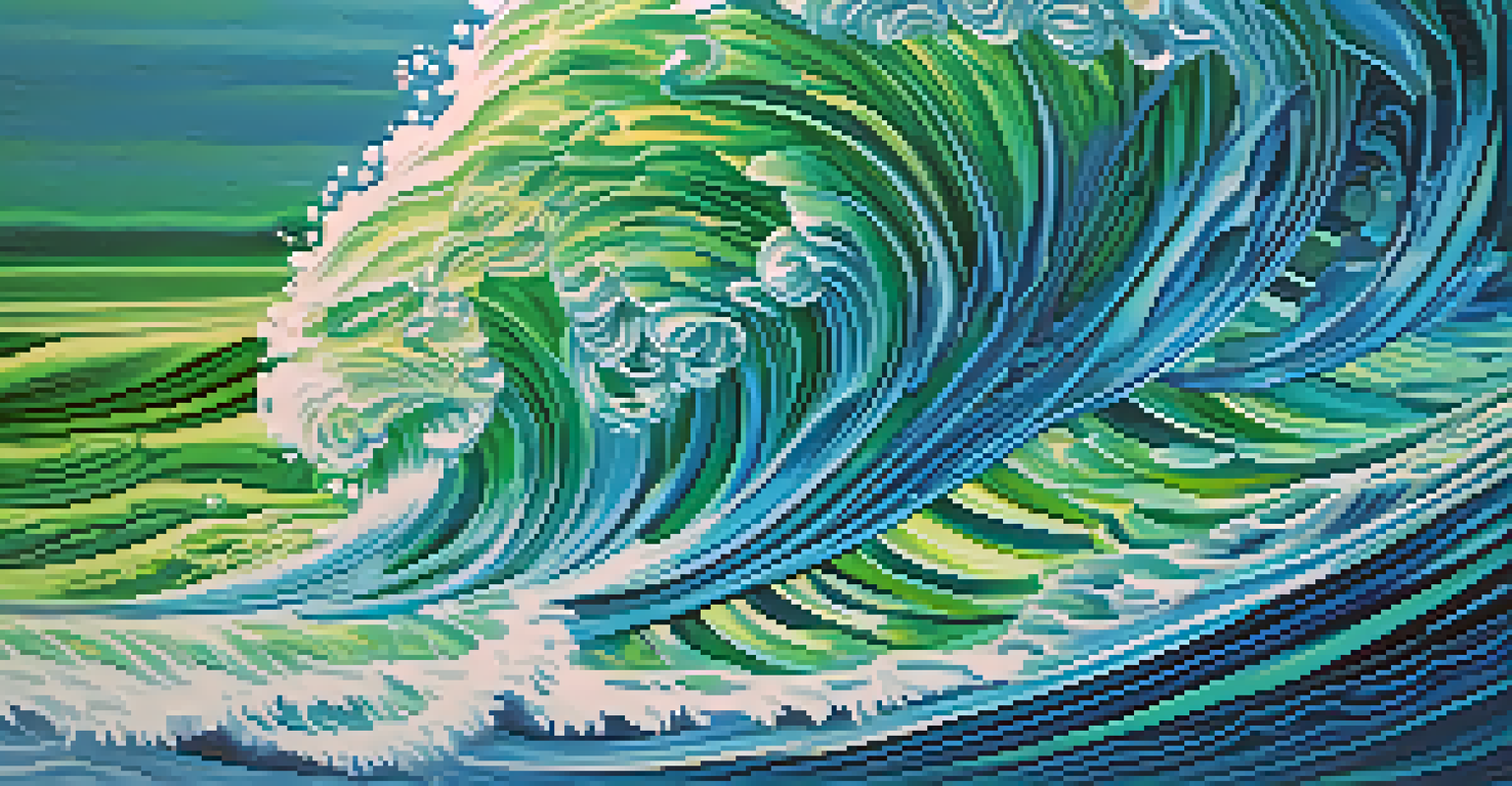The Influence of Nature in Contemporary Art Movements

Nature as a Central Theme in Modern Art
In contemporary art, nature isn’t just a backdrop; it’s often the main character. Artists today draw inspiration from natural landscapes, flora, and fauna, reflecting our changing relationship with the environment. Through various mediums, they capture the beauty and fragility of nature, inviting viewers to appreciate and engage with the natural world in new ways.
Art is a way of survival.
For instance, the work of artists like Olafur Eliasson highlights how nature can transform our perception of space and time. His installations often incorporate elements like light and water, creating immersive experiences that mimic natural phenomena. Such works challenge us to consider our impact on the environment and our role within it, making nature a vital conversation starter.
Furthermore, nature-themed art often serves as a critique of contemporary society. By juxtaposing man-made structures with organic forms, artists like Maya Lin encourage us to reflect on urbanization and environmental degradation. This blend of beauty and critique underscores the significance of nature in modern art movements.
Ecological Art and Environmental Activism
Ecological art, or eco-art, has emerged as a powerful movement that combines artistic expression with environmental activism. Artists in this field use their work to raise awareness about ecological issues, from climate change to habitat destruction. They often engage directly with communities, inspiring collective action toward sustainability.

Take the example of Chris Jordan, whose work visually represents the scale of waste generated by modern society. His series, 'Midway: Message from the Gyre,' showcases the impact of plastic pollution on wildlife, particularly seabirds. By transforming statistics into poignant visuals, Jordan compels audiences to confront the environmental crisis in a deeply personal way.
Nature as Art's Central Character
Contemporary artists use nature not just as a backdrop but as a focal point, exploring our changing relationship with the environment.
Moreover, eco-artists frequently utilize recycled materials and sustainable practices in their creations. This not only reduces waste but also sends a strong message about the importance of mindful consumption. In doing so, they create art that is not only visually striking but also environmentally conscious.
Nature's Influence on Abstract and Conceptual Art
The influence of nature extends beyond representational art into abstract and conceptual realms. Artists often use organic forms and patterns as a source of inspiration, leading to innovative interpretations of natural phenomena. This approach allows for a deeper exploration of the essence and emotions tied to nature itself.
The earth has music for those who listen.
For example, artists like Georgia O'Keeffe transformed flower shapes into bold, abstract forms that evoke feelings of intimacy and vastness. Her work encourages viewers to see nature not just as it is but as a source of emotional and sensory experience. This abstraction creates a dialogue between the viewer and the natural world, fostering a sense of connection.
Furthermore, contemporary conceptual artists may use nature as a medium to convey complex ideas. For instance, artist Robert Smithson's 'Spiral Jetty' integrates earth and water into a monumental land art piece, prompting discussions about entropy and the passage of time. Such works push the boundaries of what art can be, merging natural elements with philosophical inquiry.
Cultural Reflections of Nature in Art
Nature's portrayal in contemporary art often reflects cultural values and beliefs. Different cultures interpret and represent nature in unique ways, shaping the narrative of environmental awareness. This diversity enriches the global art scene, allowing for a multitude of perspectives on nature’s significance.
For instance, Indigenous artists frequently incorporate traditional ecological knowledge into their artworks, showcasing the deep spiritual connections between their communities and the land. This approach not only preserves cultural heritage but also emphasizes the importance of sustainability and respect for nature. Through their art, they advocate for the protection of their environments, bridging the gap between tradition and modernity.
Eco-Art Combines Art and Activism
Ecological art serves as a powerful movement that raises awareness about environmental issues while promoting sustainability through artistic expression.
In contrast, urban artists might reflect on nature's presence—or absence—in city landscapes. By highlighting forgotten green spaces or the resilience of nature amidst concrete, they provoke thought about the relationship between urban development and environmental preservation. These cultural reflections prompt viewers to consider their own connections to nature in a rapidly changing world.
Nature in Digital and New Media Art
The rise of digital and new media art has opened exciting avenues for exploring nature's influence. Artists now utilize technology to create immersive experiences that blend the virtual and natural worlds. This fusion not only captivates audiences but also encourages innovative ways of engaging with environmental themes.
For instance, augmented reality (AR) installations can superimpose digital elements onto real-world landscapes, allowing viewers to visualize the impact of climate change or habitat loss. Artists like Marina Zurkow use animation and interactive elements to narrate environmental stories, making the experience both educational and entertaining. This tech-driven approach brings nature’s challenges to the forefront while maintaining a sense of wonder.
Additionally, social media platforms have become tools for environmental advocacy through art. Artists can share their work with global audiences, sparking conversations around ecological issues. This instant connectivity fosters a sense of community, encouraging collective action toward the preservation of nature.
The Therapeutic Power of Nature in Art
Nature has long been associated with healing and well-being, and contemporary art movements often reflect this connection. Many artists draw inspiration from nature to create works that promote mindfulness and tranquility. This therapeutic aspect of art resonates with audiences seeking solace in an often chaotic world.
For example, artists like Andy Goldsworthy use natural materials to create temporary installations that invite contemplation. His work emphasizes the beauty of impermanence, mirroring the cycles of nature. By engaging with these installations, viewers can experience a sense of peace and connection to the environment.
Cultural Perspectives on Nature's Role
Different cultures reflect their unique values and beliefs about nature through art, enriching the global dialogue on environmental awareness.
Moreover, art therapy programs frequently incorporate nature-based themes and activities. These programs harness the calming effects of nature to facilitate healing and personal growth. By blending art and nature, participants often find new ways to express their emotions and foster resilience.
The Future of Nature in Contemporary Art
As we look to the future, the role of nature in contemporary art is likely to evolve alongside societal changes. With increasing awareness of environmental issues, artists will continue to explore and respond to nature's complexities. This ongoing dialogue will shape how art reflects and influences our relationship with the environment.
Emerging technologies such as virtual reality (VR) and artificial intelligence (AI) may also play a role in this evolution. Artists could create interactive experiences that allow viewers to engage with nature in innovative ways, fostering a deeper appreciation for the natural world. This fusion of art and technology has the potential to inspire new movements centered around sustainability.

Ultimately, the influence of nature in contemporary art will remain a powerful force, encouraging us to reflect on our values and actions. As artists continue to push boundaries and challenge perceptions, we can expect to see a rich tapestry of works that celebrate, critique, and advocate for nature in all its forms.